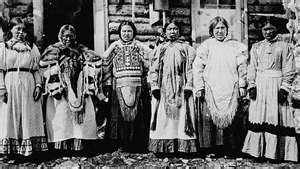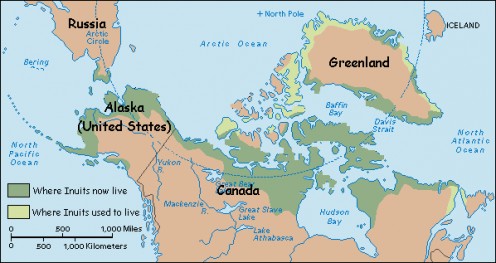The Kinship of the Inuit of the Arctic

Imagine living in a small ice shelter insulated with the skins of seals moving from one location to another during the change of the seasons, only to leave an empty shell of a home behind. There would be accumulation of very little personal possessions as this would result in an over encumbrance when moving from place to place. This is the life of a Nestilik Inuit. These people live in what is described as a marginal environment throughout the Canadian Arctic and subarctic. A marginal environment is described as a place where it is impossible for individuals to cultivate food due to environmental hindrances. The Inuit are considered to be a foraging community who heavily relies on their environment for sustenance. The motivations of the Inuit are influenced by their driving force to survive. There are three behaviors of the Inuit influenced by their kinship and culture which will be further explored. These behaviors include communal fusion and fission, general reciprocity, and ritual or ceremonial participation.
As previously mentioned, the Inuit rely heavily on their environment for survival. The Inuit’s success in survival is primarily due to their settlement patterns. Ecological changes influence the food sources available at different times of the year. It is important for the Inuit to follow where these resources are abundant. The Inuit depend on animals, predominantly the seal as their primary source of nutrition in the wintertime. During the winter months the Inuit band together with neighboring households, approximately 15 families altogether, for optimal hunting. This act of “coming together” is called fusion (Nowak, B., & Laird, P. (2010) 3.4). The Nestilik divide into smaller groups during the summer. It is more beneficial for reduced numbers of bands to hunt and fish in the summer months. They also supplement their diets with berries and roots throughout the warm season. The division of bands is called fission. “Fission reduces the stress on the environment, helping to eliminate the possibility of over–exploitation of a resource or hunger due to scarcity” (Nowak, B., & Laird, P. (2010) 3.4). The importance of migration, fission and fusion are vital to the survival of the Inuit. They have been doing this successfully for thousands of years.
Although the Inuit have been effectively living in the marginal environment of the Arctic for thousands of years, scarcity of food resources do happen on occasion. During these times of depravity, it is common practice for the Inuit to share their bounty with other households. Sharing food with other households when food is limited ensures the survivability of the whole group. This practice is called generalized reciprocity. “Generalized reciprocity is a form of exchange in which there is no expectation for the immediate return of an item in exchange for something else; in the long run, things are expected to even out” (Nowak, B., & Laird, P. (2010) 3.3). The purpose of this type of exchange is for no one to go without; with the hope that the favor will be returned during their time of need.

Everyone has some type of belief system, whether it is Atheism or Catholicism. The Inuit are no different. During the winter months, when the Inuit are gathered in large numbers, healing rituals and ceremonies are a significant part of their social life (Nowak, B., & Laird, P. (2010) case study 3.2). The Nestilik believe they have a strong connection to animal spirits and perform ritualistic practices in the pursuit of balance. In the short film Complete Inuit shaman life story 1922, a Shaman explains how balance is essential for the survival of his people (isumaproductions, 2006). He further describes social taboos and their negative effects on the household if these rules or ideals are disobeyed. These violations affect the whole household and may be detrimental to their survival by causing illness among the people or triggering a shortage of provisions.
The Nestilik Inuit’s culture is mostly motivated by their need to survive. Communal fusion and fission, general reciprocity, and ritual or ceremonial participation are considered vital to the Inuit’s way of life. There is some evidence of fusion witnessed in American culture, mostly prevalent in minority or immigrant families. Examples of this are seen with extended families living together, sharing their income to sustain the whole family. General reciprocity is not a behavior that is typically viewed in American culture. The majority of American people appear to practice balanced reciprocity, believing if a gift is given, then an offering of equal or greater value is expected in return. However, this is principle is not shared collectively. Generalized reciprocity can be observed by individuals who practice Hinduism or Buddhism, by abiding to the fundamental doctrine of Karma. Although Americans and the Inuit share ideas of taboos, our reasons are based on social norms rather than the need for a continued existence. Cultural universals are clearly seen between American and Inuit culture, but the driving forces of these universals are very different. Clearly, the Inuit behaviors are motivated principally for the perseverance of these people, from migration to religious practices.
References:
Complete Inuit shaman life story 1922 . (2006, September 27). Retrieved March 11, 2011, fromisumaproductions website: http://www.youtube.com/watch?v=Kxdqjn1sFM8
Nowak, B., & Laird, P. (2010). Band Societies. In Discovery Series: Cultural Anthropology (pp. 3,4). Retrieved from http://content.ashford.edu/books/AUANT101.10.2









